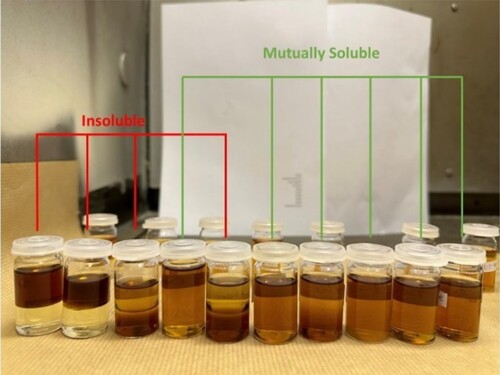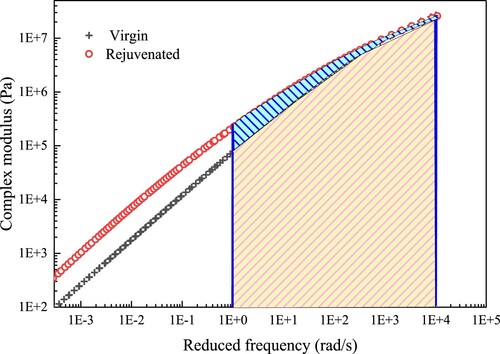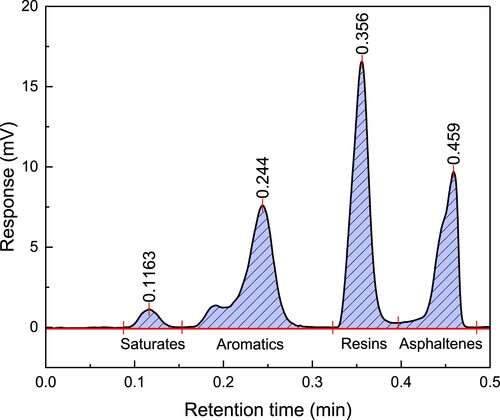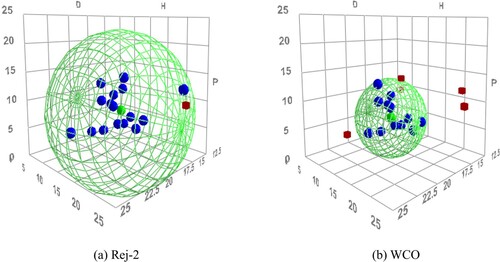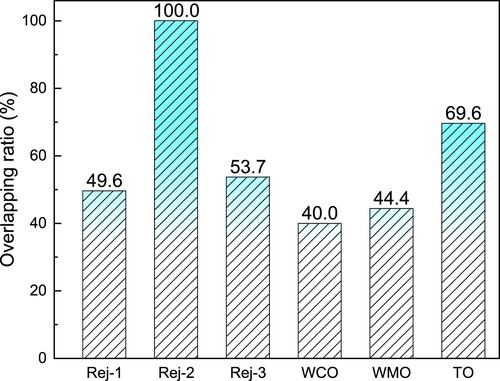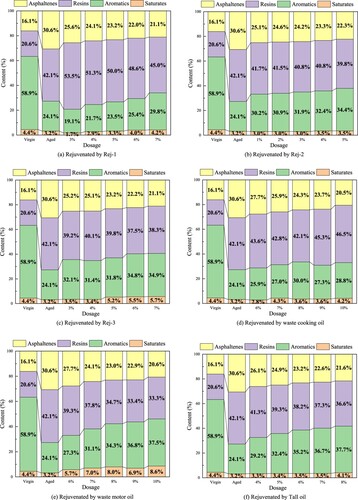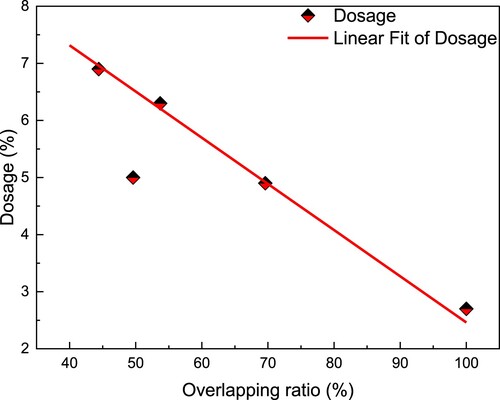 ?Mathematical formulae have been encoded as MathML and are displayed in this HTML version using MathJax in order to improve their display. Uncheck the box to turn MathJax off. This feature requires Javascript. Click on a formula to zoom.
?Mathematical formulae have been encoded as MathML and are displayed in this HTML version using MathJax in order to improve their display. Uncheck the box to turn MathJax off. This feature requires Javascript. Click on a formula to zoom.Abstract
While there is considerable research regarding the recycling and reuse of aged bitumen in terms of the evaluation of rheological properties, there is not much fundamental understanding regarding the underlying mechanisms of the rejuvenation process. Specifically, the rationale behind rejuvenator selection and the efficiency of rejuvenators is not well understood. This paper proposes an approach for rejuvenator selection based on Hansen Solubility Parameters (HSP). To fully validate its feasibility, rheological and chemical tests were also performed. The results revealed that highly efficient rejuvenators have similar HSP with bitumen and greater HSP radii. The overlapping ratio between the Hansen spheres of bitumen and rejuvenators could be considered as a reliable tool to screen rejuvenators. Linear correlations were found between the efficiency of rejuvenators and solubility spheres. The rheological and chemical tests using master curve analysis and saturates, aromatics, resins and asphaltenes (SARA) fractionation further supported using HSP as a basis for rejuvenator selection.
Introduction
Ageing of bitumen is the predominant cause of the deterioration in the performance of asphalt pavement. Serious distresses in asphalt pavements are induced due to the ageing of bitumen, such as map cracking, potholes, stripping, etc. (Baek et al., Citation2012; Hu et al., Citation2022, Citation2024; Wu et al., Citation2024a). Reusing the aged bitumen in reclaimed asphalt pavement (RAP) is a sustainable approach to save natural resources like fresh bitumen and aggregates, saving up to 70% of costs for the reconstruction of asphalt pavement (Devulapalli et al., Citation2019). In addition, in-site recycling of asphalt can also reduce transportation costs, energy consumption, the need for landfill, and greenhouse gas emissions, which is beneficial for both the economy and the environment (Oldham et al., Citation2018; Omairey et al., Citation2024). A critical technology for reusing the RAP is the rejuvenation of aged bitumen, given that the property changes of aggregates during ageing are much less significant than bitumen (Zhang et al., Citation2021a). Therefore, the understanding of the bitumen rejuvenation mechanisms, approaches and quality controls are of great significance to bitumen practitioners.
Although both economic and environmental benefits can be extended from reusing the aged bitumen for new pavement construction, the average RAP content used in reconstructed asphalt pavements is still limited, due to issues such as premature cracking (Oldham et al., Citation2018; Oldham et al., Citation2019; Rajib et al., Citation2020). The additional stiffening of the mix caused by the aged binder in RAP is assumed to be responsible for these issues. Considering this, rejuvenators, also known as rejuvenation agents, are of great importance to soften the aged bitumen. In the practice of reusing RAP, normally the aged bitumen is blended with the fresh bitumen together with the rejuvenators. However, some previous studies have reported that although the aged bitumen is softened, a high concentration of RAP may alter the extent of internal stability in the combined blends and could consequently have implications in terms of binder compatibilities and blend homogeneity (Sreeram et al., Citation2020 , Xu et al., Citation2024). An ideal rejuvenator should have the ability to soften the aged bitumen and reduce the incompatibility between fresh and aged bitumen, thereby improving the overall performance of pavements with RAP (Wu et al., Citation2024b).
Though previous research and practice have shown that the performance of recycled bitumen can be improved significantly with the presence of rejuvenators, the mechanisms of rejuvenation are still unclear (Shi et al., Citation2024). The majority of research efforts have focused on the rheological and mechanical properties of rejuvenated bitumen (Lin et al., Citation2021; Sotoodeh-Nia et al., Citation2021; Zahoor et al., Citation2021; Zhang et al. Citation2021b), while the rejuvenation mechanisms have not been well-understood (Kabir & Fini, Citation2021). In terms of rheology, the low-temperature and fatigue properties of aged bitumen can be improved using rejuvenators without reducing its high-temperature performance (Dokandari et al., Citation2021). However, the criterion for selecting rejuvenators is largely based on empirical trial and error approaches.
In addition to rejuvenator selection, another critical procedure for the rejuvenation of RAP is dosage optimisation. Multiple targets and parameters have been used to determine the ideal dosages for some individual rejuvenators. The commonly used targets include penetration, viscosity, and PG grade. (Ma et al., Citation2020; Mamun & Wahhab, Citation2020; Nsengiyumva et al., Citation2020). These indices provide straightforward metrics regarding rejuvenation effectiveness in terms of rheology. However, such indices are measured at a single point basis, for instance, single temperature or single frequency, which fail to capture the comprehensive properties of rejuvenated bitumen. Moreover, the empirical approaches are affected by uncertainty, resulting in relatively lower reliability in choosing proper rejuvenators and determining the optimal dosages.
Previous studies have reported that ageing of bitumen can be attributed to the loss of maltene fractions in bitumen, leading to lower levels of colloidal stability. This is caused by the oxidation of bitumen, which is the chemical reaction between oxygen and the less polar molecules within bitumen, thereby forming some highly polar components such as asphaltenes (Davis & Petersen, Citation1966; Petersen et al., Citation1994; Petersen & Glaser, Citation2011 Petersen & Harnsberger, Citation1998;). Therefore, the rejuvenators should theoretically provide more maltene-like fractions to recover the internal stability of bitumen. To this end, in order to ensure the optimum extent of rejuvenation, there should be high levels of compatibility between rejuvenators and bitumen. One useful tool to potentially characterise the compatibility of rejuvenators and bitumen is the use of solubility parameters. Solubility parameters, first proposed by Hilderbrand and Scott (Hildebrand & Scott, Citation1950), have been proven useful for many applications, such as the prediction of chemical resistance, polymer compatibility and permeation rate. The main idea between solubility parameters is that if two materials have similar solubility parameters, they are believed to have good compatibility or be mutually soluble. A commonly used solubility-based model is the Hansen solubility parameter (HSP) which was proposed by Hansen (Hansen, Citation1969). The basis of HSP is that the total energy of the vaporisation of a liquid consists of several individual parts (Hansen, Citation2007). These arise from dispersion forces (δD, MPa1/2), dipole (polar) forces (δp, MPa1/2), and hydrogen bonding (electron exchange) (δH, MPa1/2). Materials with similar HSP are in theory supposed to have high affinity and compatibility. The HSP dimensional equation can be represented as shown in Equation (1).
(1)
(1) where δT is the total solubility parameter of a material. Apart from the three dimensions of HSP, every material has its solubility radius, which represents its entire soluble capacity. Using the three dimensions of HSP as the coordinate centre, together with the radius, a three-dimensional sphere can be visualised, which is termed as the ‘Hansen Sphere’. The relative position of the spheres for two materials can be used to characterise the affinity between them. In terms of the application of HSP in bituminous binders, Redelius first introduced the bitumen solubility model to describe the solubility of different molecules of bitumen (Redelius, Citation2000). Apart from this, other studies have investigated the compatibility between bitumen and modifiers, for example, the feasibility of using different plastics as modifiers or co-modifiers (Gallu et al., Citation2021; Gallu et al., Citation2022, Sreeram et al., Citation2022), the phase-separation behaviour of modified bitumen (Gallu et al., Citation2020), etc. Moreover, the interactions between different types of bitumen have also been investigated using the HSP method (Sreeram et al., Citation2019, Sreeram et al., Citation2020). For illustration, the Hansen spheres for bitumen and four common chemicals used are shown in Figure .
Figure 1. Hansen space for bitumen and other chemicals (Source from (Sreeram et al., Citation2019)).
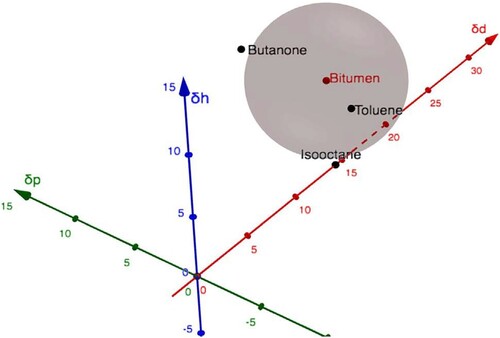
As observed, the centre of the bitumen sphere is close to that of toluene indicating compatibility (and solubility) whereas the non-solvents (butanone, iso-octane and ethyl hexanol) are further apart which indicates non-compatibility and poor dissolution. This observation can be extended to the bitumen modifiers. Good modifiers have close solubility parameters to bitumen thereby avoiding compatibility issues (Gallu et al., Citation2021, Sreeram et al., Citation2022). Poor compatibility between bitumen and modifiers can potentially lead to phase separation, reducing the functional effectiveness of modifiers.
Overall, the HSP has shown to be a powerful tool to characterise the compatibility between bitumen and modifying agents. However, there is no research that has attempted to link the solubility parameters with the efficiency of rejuvenators. Additionally, the selection of rejuvenators is mainly based on empirical trials, without consideration of the compatibility between bitumen and rejuvenators. The use of solubility parameters could potentially provide an effective approach for rejuvenator selection as well as dosage optimisation. To this end, this study investigates the use of Hansen solubility parameters (HSP) in the selection of highly effective rejuvenators.
Scope
This study aims to investigate the feasibility of using Hansen Solubility Parameters (HSP) to examine the interaction between bitumen and rejuvenators to aid in the selection and dosage of effective rejuvenators. To achieve this aim, six different rejuvenators were employed in this study and their compatibility with bitumen was tested using solubility-based methods. In addition to the solubility testing, rheological and chemical tests were also carried out to support the feasibility of the solubility-based rejuvenator selection approach. The rheological and chemical tests carried out consisted of using master curve binder analysis and saturates, aromatics, resins and asphaltene (SARA) fractionation respectively.
Materials and methodologies
Materials
The bitumen used in this study was a 70/100 penetration grade bitumen with a PG grade of PG 70-22. The penetration of the bitumen was 81 (0.1 mm) and the softening point was 45.4oC. Six rejuvenators were used in this investigation, among them, three were commercial bio-based products referred to as Rej-1, Rej-2 and Rej-3 respectively. The other three rejuvenators were not commercialised, one was waste cooking oil with high viscosity referred to as WCO, followed by re-refined waste motor oil referred to as WMO, and lastly tall oil referred to as TO. All rejuvenators were deep-coloured liquids at room temperature, as shown in Table .
Table 1. Description and appearance of rejuvenators.
Methodologies
Ageing and Rejuvenation procedures
The virgin bitumen was artificially aged using a rolling thin film oven (RTFO) at 163°C for 75 mins as per BS EN 12607-1 (BSI, Citation2014b) to simulate the short-term ageing. Afterwards, the residue was then subjected to pressure ageing vessel (PAV) ageing at 100°C and 2.1 MPa for 20 hours as per BS EN 14769 (BSI, Citation2014a). After ageing, the bitumen was rejuvenated using bio-rejuvenators.
The determination of initial dosages for individual rejuvenators is based on two metrics: The manufacturers’ manual and literatures. Firstly, a dosage within the recommended range from either the manual or literatures was selected, and then the tests and analysis were carried out. If overdosing is found, the dosage for the next set of testing is reduced. If underdosing was found, the dosage for the next set of testing was increased. Ultimately, five continuous dosages with both overdosing and underdosing could be obtained.
In terms of the rejuvenation procedures, firstly, the aged bitumen was heated in an oven at 160oC for 30 mins, then it was put on a heat plate to maintain the temperature. The rejuvenators were accurately weighted at the designed dosages and then added to the aged bitumen. The mixtures of aged bitumen and rejuvenators were blended for 10 minutes to get homogeneous rejuvenated binders.
Hansen Solubility Parameters (HSP) of rejuvenators and bitumen
The Hansen Solubility Parameters of rejuvenators and bitumen were measured using 27 solvents with known HSP values, as shown in Table . The solvents were chosen specifically to cover a wide range of HSPs to determine the HSPs of rejuvenators and bitumen as accurately as possible.
Table 2. Solvent list for the measurement of the HSP of rejuvenators and bitumen.
For the measurement of the HSP of bitumen, one gram of bitumen was dissolved into 5 ml of each solvent in a glass vial with a cap. Afterwards, the vials were stored at room temperature in a fume hood for 24 hours. During this period, the vials were shaken at regular intervals. At the end of the tests, the results were classified into two categories: mutually soluble and not soluble. For the mutually soluble results, the bitumen was completely dissolved in the solvents and the solvents were marked as ‘good’ solvents. For the insoluble results, bitumen was either not-dissolved or some residue could be observed at the bottom of the vials, then the solvents were considered as ‘poor’ solvents (Hansen, Citation2007, Sreeram et al., Citation2022). Ultimately all results were recorded and analysed using the software named HSPiP to compute the estimated HSP of the bitumen. The measurement of the HSPs for rejuvenators was similar to that of bitumen, 5 ml of rejuvenators were mixed with 5 ml of solvent, then the results were observed and recorded. If the two liquids were mutually soluble, there was a homogeneous blend observed. If not soluble, a distinct boundary between two liquids can be observed, the results are illustrated in Figure .
Rheological testing of bitumen
Frequency sweep tests were conducted at a constant strain level of 0.2% to ensure the linear viscoelastic (LVE) response of the bitumen over the temperature range of 10–70°C at an interval of 10°C and frequencies ranging from 0.1 rad/s to 100 rad/s with 10 frequencies per decade. The DSR test geometry configuration consisted of 25 mm parallel plates with a gap of 1 mm.
The rheological property of bitumen is one of the most common methods to evaluate the performance of bitumen. To investigate the efficiency of rejuvenators, a master curve-based rejuvenation index was adopted. The modified Christensen – Anderson – Marasteanu (CAM) model (Christensen, Citation1998) was used to visually portray the relationship between the complex modulus and frequency of bitumen (Bahia et al., Citation2001). The shift factor α(T) for building master curves was obtained using equation (2):
(2)
(2)
where,
= Shifting parameters
T = Testing temperature, °C
TR = Reference temperature, °C
The modified CAM model (Bahia et al., Citation2001) as shown in Equation (3) was employed to build the master curves of the complex modulus (|G*|) of bitumen at the reference temperature of 25°C.
(3)
(3) where,
G*g = glass complex modulus.
fc = crossover frequency.
fr = reduced frequency.
m,k = fitting parameters.
To quantify the holistic impact of rejuvenation on the rheological properties of bitumen, the rejuvenation index was proposed, as defined in Equation (4), which is a further modification of previous work (Cavalli et al., Citation2018; Poulikakos et al., Citation2019). Ageing mainly has a negative effect on the low-temperature performance of bitumen, such as delta Tc, etc. (Margaritis et al., Citation2021), therefore, the boundaries of the integration were set as 0 and 4 respectively to target the complex modulus generally found at low temperatures (high frequencies), as shown in Figure . The rejuvenation index was defined as the ratio of the integration areas of rejuvenated and virgin bitumen (Hu et al., Citation2024). Therefore, it equals the sum of blue and yellow shadowed areas divided by the yellow shadowed area.
(4)
(4)
SARA analysis for bitumen with varying ageing and rejuvenation situations
The polarity-based constituents of bitumen were detected by thin-layer chromatography with flame ionisation detection (TLC-FID). The principle of this test is separating the generic fractions of bitumen in terms of their solubility in dedicated solvents. The saturates were separated from other more polar components due to their good solubility in n-heptane and weak strength of interaction with the adsorbent (silica). Finally, the most polar and insoluble asphaltenes were left at the bottom of the chroma rods.
Firstly, the bitumen was dissolved in dichloromethane to procure a solution with a concentration of 2% (weight/volume). Then, 1 µl of the solution was spotted carefully on the zero scale of the chroma rods. Prior to this, the chroma rods were cleaned by running them through the FID flame twice to remove any residue left previously. Then the SARA fractions separation was carried out in three phases in tanks which consisted of n-heptane; 80/20 toluene/n-heptane blend and 95/5 methylene dichloride/methanol blend for the saturates, aromatics and resins respectively. The chroma rods were developed in succession in each of the solvents. Then the chroma rods were dried in the oven for 90 s at 80°C. The dried chroma rods were then scanned in the Iatroscan MK6s SARA detector at a frequency of 40 scans per second. The air and hydrogen flow rates were set at 2 L/min and 160 mL/min, respectively (Lu et al., Citation2008).
As per the solubility with different elution solvents, every fraction will appear at specific positions on the chroma rods, the retention time can distinguish different fractions, as illustrated in Figure . Every peak corresponds to a specific fraction of saturates, aromatics, resins and asphaltenes. The areas between the peaks and baseline are recognised as their contents, which can be calculated automatically using the built-in software.
Results and discussion
Hansen solubility parameters of rejuvenators and bitumen
The HSP values of the different rejuvenators as well as bitumen were measured using 27 solvents. For illustration purposes, the HSP spheres of two rejuvenators, (a) commercial product (Rej-2) and (b) WCO waste cooking oil, are shown in Figure .
The green meshes seen are the HSP spheres of these two rejuvenators. Within the spheres, there are some blue dots, which indicate the soluble solvents. On the contrary, the red squared shapes outside the spheres are the insoluble solvents. Clearly, the solubility parameters of these two illustrated rejuvenators are different, Rej-2 is mutually soluble with most of the solvents used in the experiment, therefore the radius of its sphere is relatively greater. However, waste cooking oil is only soluble with certain solvents, leading to a relatively smaller radius. Moreover, the centres of spheres are different in Hansen space as well, illustrating different values in the three dimensions of the solubility parameters and the results are summarised in Table . It must be noted that the HSP values listed are not absolute indicators of a material’s solubility. Using different types and amounts of solvents for the measurement of the HSP of a material might give slightly different results. However, with the wide range of solvents tested, the value of HSP can be considered as a reasonable estimate of where materials solubility would lie when using the Hansen model. These results could be used to illustrate the differences between bitumen and rejuvenators in terms of solubility properties.
Table 3. Hansen solubility parameters of the used materials.
When evaluating the HSP values, it was observed that the molecular interactions of both bitumen and rejuvenators are dominated by dispersive forces, also named London forces. Polar forces and hydrogen bonding forces also contribute to the molecular interactions but to a lesser extent. The London forces are due to temporary dipoles caused by fluctuations in the electrons surrounding a molecule. Acting as an attraction force in all directions between molecules, the fluctuations affect the physical properties of materials such as increasing boiling point, viscosity, heat of vaporisation, etc. (Redelius & Soenen, Citation2015). The dispersive interaction is regarded as the most important interaction for the non-polar hydrocarbons and for the physical properties of bituminous binders. There was no significant difference between the dispersive forces of bitumen and rejuvenators.
The polar and hydrogen bonding interactions are due to an imbalance of the electron distribution in a molecule where atoms with different electronegativity are connected by covalent bonds (Redelius & Soenen, Citation2015). The polar and hydrogen bonding interactions are lesser than the dispersive interaction for both bitumen and rejuvenators. In terms of bitumen, the heteroatoms such as nitrogen and oxygen are responsible for the polar interactions. A previous study revealed that the polar interactions are related to the elastic part of the complex modulus of bitumen (Redelius & Soenen, Citation2011). Bitumen consists of more sulphur than nitrogen and oxygen. It is known that sulphur has electronegativity very close to carbon and hydrogen and does not contribute substantially to polarity (Yuan et al., Citation2023). This is one of the reasons why the polar interaction of bitumen is limited. However, ageing introduces more oxygen to bitumen, leading to an increase in polar interaction. Based on the results from Table , it was found that all polar interactions of rejuvenators are different from those of bitumen. Similar observations were also found for the hydrogen bonding interaction except for Rej-3. In terms of the radius of the Hansen sphere, it was observed that bitumen has a radius of 10.1, smaller than those of Rej-2 and tall oil while greater than those of other rejuvenators, suggesting that Rej-2 and tall oils can be soluble in a wider range of materials compared to other rejuvenators.
The compatibility between bitumen and rejuvenators was determined by all three parameters of the HSP model rather than a single parameter. The distance between two materials can be calculated using Equation (5), which is based on their respective partial solubility parameter components.
(5)
(5) where, Ra is the distance between two materials, here, it’s the distance between bitumen and rejuvenators, δD1, δD2, δP1, δP2, δH1, δH2 are the HSPs for bitumen and rejuvenators. Subsequently, the Ra for different rejuvenators can be computed, as shown in Table
Table 4. The distance between bitumen and rejuvenators.
Table suggests that the distances between bitumen and Rej-1, Rej-2, WCO and WMO are comparable while that between bitumen and Rej-3 is significantly smaller, and that between bitumen and TO is significantly greater. However, in terms of this index, Hansen sphere radius, which has a significant influence on the compatibility, was not considered. Subsequently, another index, named relative energy difference (RED) was proposed (Hansen, Citation2007), which incorporates the radius. The calculation of RED can be represented by Equation (6). The results of RED are summarised in Table . Where, Ro is the radius of rejuvenators.
(6)
(6) A value of zero suggests that there is no energy difference between two materials, a value greater than one suggests lower affinity while a value smaller than one indicates higher affinity (Hansen, Citation2007). The RED provides a more reasonable result for the affinity between bitumen and rejuvenators. Among six rejuvenators, Rej-2, Rej-3 and TO stand out, illustrating better affinity and potentially better rejuvenation efficiency. On the contrary, Rej-1, WMO and WCO were found to have poorer compatibility and affinity with bitumen. It should be noted that though RED provides a more comprehensive understanding of the compatibility between two materials, it is ultimately ‘distance’ based, meaning that it is a two-dimension index. However, the Hansen sphere is a three-dimension space, which requires more detail to have a more thorough understanding. Three dimensions of HSPs can be plotted in a 3D sphere, which visualises the values of each material. For comparison purposes, the sphere for each rejuvenator was plotted together with bitumen, as shown in Figure . The light green sphere is bitumen’s while the light purple spheres are for rejuvenators. It’s evident from Figure that all spheres of rejuvenators partially overlapped with that of bitumen, suggesting that they were somewhat mutually compatible or partially compatible. Notably, the sphere of bitumen was completely located inside that of Rej-2 and the majority of it was located inside that of tall oil.
Table 5. Relative energy difference between bitumen and rejuvenators.
To quantify this, the volumes of each sphere were calculated. Given that the HSPs of rejuvenators and bitumen were similar, there were some overlapping regions between the spheres of rejuvenators and bitumen. The volumes of overlapping areas were also calculated. Ultimately, the volumes of overlapping areas were divided by that of the bitumen to get the overlapping ratio, which is depicted in Figure .
Figure indicates that Rej-2 has the largest overlapping ratio, making it mutually compatible with a large range of materials, like bitumen. Therefore, using materials like Rej-2 to recover the physical properties of aged bitumen may be an effective approach assuming that the rejuvenation efficiency of rejuvenators should be positively related to the solubility and compatibility between rejuvenators and bitumen. Apart from this, tall oil also showed good affinity compatibility with the bitumen. The other rejuvenators showed insufficient solubility affinity with bitumen, which might result in relatively weak rejuvenation efficiency. These results are verified in the next sections using other rheological and chemical tools.
Rheological efficiency of rejuvenators
The Rejuvenation indices (RI) of various binders were evaluated as described in the subsection of rheological testing methodology. The binders were the PAV-aged binders subsequently rejuvenated by varying rejuvenators. Mathematically, RI values greater than one indicate that bitumen is aged or insufficiently rejuvenated, while RI values smaller than one indicate over-rejuvenation. Therefore, the closer RI is to one, the better the rejuvenation effectiveness. From the calculations, it was found that RI is linearly correlated with the dosages. Given that, regression relationships can be obtained between the dosages and the RIs, as shown in Table .
Table 6. Relationship between dosages and rejuvenation indices.
Assigning the value of RI to one and solving these equations, the optimal dosages for each rejuvenator can be estimated. The optimal dosage for Rej-1, Rej-2 and Rej-3 calculated is 5.0%, 2.7% and 6.3% respectively. In terms of non-commercial bio-rejuvenators, the optimal dosage for waste cooking oil is 8.6%, for waste motor oil is 6.9% and for tall oil is 4.9%. Therefore, Rej-2 is believed to be the most efficient rejuvenator while waste cooking oil is believed to be the least efficient one, as Rej-2 requires the least amount of rejuvenator addition while WCO requires the most addition to achieve similar rheological parameters.
It was found that the rheological rejuvenation efficiency was similar to the compatibility indicators from the solubility parameters. The rejuvenation efficiency ranking from the most efficient to the least efficient is: Rej-2 > TO > Rej-1 > Rej-3 > WMO > WCO. The ranking is consistent with the overlapping ratio of the Hansen spheres, indicating that the compatibility between rejuvenators and bitumen could be an important factor affecting the rheological properties of rejuvenated bitumen.
SARA fraction analysis of rejuvenated bitumen
Due to the extreme complexity of the chemistry of bitumen, it is impossible to separate bitumen into individual components. One of the most feasible practices is separating bitumen into maltenes and asphaltenes, and subsequently separating maltenes into saturates, aromatics (also known as naphthene-aromatics), and resins (also known as polar-aromatics), and is commonly termed as SARA fractionation (Corbett, Citation1969). The ageing of bitumen has a significant influence on the chemistry of bitumen including SARA fractions. It is well recognised that ageing leads to a significant reduction in the content of aromatics while an increase in the contents of resins and asphaltenes. Saturates are inert to ageing, consequently, the content of saturates remains relatively stable during ageing (Hu et al., Citation2023 Lesueur, Citation2009; Loeber et al., Citation1998; Lu & Isacsson, Citation2002; Petersen, Citation2009;). Rejuvenation, however, can theoretically rebalance the changes in the chemistry of bitumen during ageing (Yu et al., Citation2014). Rejuvenators are mainly composed of light hydrocarbons and heteroatoms, therefore they are meant to compensate for the loss of light fractions of bitumen caused by ageing. The generic fractions of virgin, aged and rejuvenated bitumen were measured using the TLC-FID method. The SARA fractions of aged bitumen with varying dosages of different rejuvenators were measured, as shown in Figure .
It can be seen from Figure that the content of asphaltenes decreased after rejuvenation and the content of maltenes increased, with such trends having also been reported in literature (Guo et al., Citation2021). Generally, the fraction of resins decreases with increased dosages of rejuvenators, but some anomalies were observed as well. For example, the fraction of resins of waste cooking oil rejuvenated bitumen fluctuates with the dosages. There are two possible reasons for this: First, the waste cooking oil may be rich in resins, leading it to be more polar than other rejuvenators. The chemical components are the underlying reason why this rejuvenator is less effective compared with others. The second reason might lie in errors in the measurements given that the change in dosage is small, with the interval of increment being only 1%, leading to difficulties for the machine in distinguishing such minor differences. Nevertheless, the trend is still obvious with the less polar fractions, such as aromatics and saturates, increasing continuously with dosage.
Among the four fractions of bitumen, asphaltene is the most polar component. Previous studies have shown that a small change in the quantity of asphaltene can induce a significant change in the physical properties of bitumen (Eberhardsteiner et al., Citation2015; Mirwald et al., Citation2020a Mirwald et al., Citation2020b;). To understand the correlations between the solubility and asphaltene content, the asphaltene content of rejuvenated bitumen with a 6% dosage of different rejuvenators was analysed (for the Rej-2 rejuvenated bitumen, a 5% dosage was selected since this is the highest dosage for this rejuvenator). It was seen that the asphaltene content of Rej-2 rejuvenated bitumen is lowest at the same (or even lower) dosage. In the case of WCO and WMO which showed relatively poor compatibility with bitumen, the asphaltene content was relatively higher. This result supports the view that the compatibility between bitumen and rejuvenators impacts both the rheological and chemical properties of rejuvenated bitumen. However, it is interesting to note that although the rheological properties can be recovered to be similar to that of unaged bitumen, the chemical constitution is still quite different. This indicates that the rejuvenators could mainly be acting as binder softeners to a large extent. The implications of this in terms of long-term rheology and multiple aging cycles are still not properly understood (Makowska et al., Citation2017; Schwettmann et al., Citation2023). Therefore, the correlation between HSP, viscoelastic properties and chemical composition should be elaborated in further investigations.
Correlations between different parameters
This study investigated the solubility, rheological and chemical properties of rejuvenated bitumen. There are potentially some underlying links between these different perspectives. Investigating these interconnected links would be critical towards understanding the science behind the rejuvenation of bitumen.
The first and most essential correlation lies between the rejuvenation efficiency and the solubility parameters. The master curve-based rejuvenation index determined the optimal dosages for each rejuvenator in accordance with the rheological performance of the rejuvenated bitumen. The HSP illustrated to what extent the rejuvenators are compatible with bitumen. The correlation between these two perspectives was built, as illustrated by the red points and fitted line in Figure . It suggests that the overlapping areas between bitumen and rejuvenators are closely correlated to rejuvenation efficiency. The Pearson coefficient calculated was 0.89, suggesting that the rejuvenation efficiency linearly corresponds to the mutual solubility between bitumen and rejuvenators. Therefore, if the HSPs of rejuvenators are known, the optimal dosages could be estimated based on their correlation. The more efficient rejuvenators are those with greater solubility radii, which can potentially dissolve the hardened bitumen to create a more stable system. The softened bitumen resulting from the rejuvenation process can help create a homogeneous colloid, preventing incompatibility issues and being subsequently beneficial for the cracking resistance of reconstructed asphalt pavement. The correlation between the dosage and Hansen solubility parameters is first investigated in this paper, but previous investigations on the compatibility between polymers and bitumen suggested that solubility is closely correlated with the performance of bitumen and asphalt mixtures (Gallu et al., Citation2021, Sreeram et al., Citation2022).
These results also provide insights to help choose appropriate rejuvenators. Firstly, highly effective rejuvenators would have to have similar solubility parameters with bitumen. The similarity should consist of all aspects of solubility parameters, which are dispersive interactions, polar interactions, hydrogen bonding interactions as well as the Hansen radius. The HSP spheres of bitumen and rejuvenators should also overlap as much as possible. On the contrary, if the solubility parameters of bitumen and rejuvenators are significantly different, the rejuvenation efficiency may not be ideal, meaning that higher dosages may be required to achieve the same rejuvenation effectiveness. Moreover, poor solubility between bitumen and rejuvenators may lead to potential incompatibility between the fresh and rejuvenated bitumen, which could have an impact on the performance of the reconstructed pavement (Sreeram et al., Citation2020).
Conclusions
This study investigated the possibility of using Hansen Solubility Parameters (HSP) as a tool for the selection and dosage optimisation of rejuvenators. Six different rejuvenators were employed and their compatibility with bitumen was tested using solubility methods. Additionally, rheological and chemical tests were also carried out to assess the feasibility of the approach. Based on the experiments conducted, the main findings of the study were as follows:
The solubility parameters can effectively characterise the rejuvenation efficiency of rejuvenators to a large extent. Highly efficient rejuvenators were seen to have similar HSP with bitumen and have relatively greater HSP radii. This criterion can be potentially used in the future to aid rejuvenator selection and dosage optimisation.
When using the HSP as a metric for rejuvenator selection, the dispersive force, polar force, hydrogen bonding and the radius of the Hansen sphere should be considered simultaneously. All of these four parameters likely contribute to the compatibility between bitumen and rejuvenators.
The dosages of rejuvenators determined by the master curve-based rejuvenation index linearly correlated with the overlapping ratio between the Hansen spheres of bitumen and rejuvenators. Apart from this, the reduction in asphaltene content of rejuvenated bitumen also positively correlated with the overlapping ratio.
Overall, the work conducted in this study illustrated that the compatibility between rejuvenators and bitumen could play a crucial role in the efficiency of rejuvenators and the use of HSP-based tools can provide a useful metric for the selection of rejuvenators. Based on these fundamental findings, further research is recommended to be conducted in two areas. Firstly, it is recommended to separate bitumen into maltenes and asphaltenes and match their solubility parameters with those for rejuvenators in order to elucidate further understanding between compatibility and chemical constitution. Secondly, using the concept of HSP to investigate the feasibility of repetitive cyclic reuse of bitumen in asphalt mixes.
Acknowledgements
The first author would thank the finial support from the China Scholarship Council under grant number 202106560001.
Disclosure statement
No potential conflict of interest was reported by the authors.
Additional information
Funding
References
- Baek, C., Underwood, B. S., & Kim, Y. R. (2012). Effects of oxidative aging on asphalt mixture properties. Transportation Research Record: Journal of the Transportation Research Board, 2296(1), 77–85. Retrieved January 28, 2022. https://doi.org/10.3141/2296-08
- Bahia, H. U., Hanson, D. I., Zeng, M., Zhai, H., Khatri, M. A., & Anderson, R. M. (2001). Characterization of modified asphalt binders in superpave mix design. Washington, D.C., NCHRP REPORT 459.
- Bsi. (2014a). Bitumen and bituminous binders. Accelerated long-term aging conditioning by a pressure aging vessel (pav). BSI London, UK.
- Bsi. (2014b). Bitumen and bituminous binders. Determination of the resistance to hardening under influence of heat and air. Rtfot method. BSI London, UK.
- Cavalli, M. C., Zaumanis, M., Mazza, E., Partl, M. N., & Poulikakos, L. D. (2018). Effect of ageing on the mechanical and chemical properties of binder from rap treated with bio-based rejuvenators. Composites Part B: Engineering, 141, 174–181. https://doi.org/10.1016/j.compositesb.2017.12.060
- Christensen, D. (1998). Analysis of creep data from indirect tension test on asphalt concrete. Journal of the Association of Asphalt Paving Technologists, 67, 458–492.
- Corbett, L. W. (1969). Composition of asphalt based on generic fractionation, using solvent deasphaltening, elution-adsorption chromatography, and densimetric characterization. Analytical Chemistry, 41(4), 576–579. https://doi.org/10.1021/ac60273a004
- Davis, T. C., & Petersen, J. C. (1966). Adaptation of inverse gas-liquid chromatography to asphalt oxidation studies. Analytical Chemistry, 38(13), 1938–1940. https://doi.org/10.1021/ac50155a070
- Devulapalli, L., Kothandaraman, S., & Sarang, G. (2019). A review on the mechanisms involved in reclaimed asphalt pavement. International Journal of Pavement Research and Technology, 12(2), 185–196. https://doi.org/10.1007/s42947-019-0024-1
- Dokandari, P. A., Topal, A., & Ozdemir, D. K. (2021). Rheological and microstructural investigation of the effects of rejuvenators on reclaimed asphalt pavement bitumen by DSR and AFM. International Journal of Civil Engineering, 19(7), 749–758. https://doi.org/10.1007/s40999-021-00605-z
- Eberhardsteiner, L., Füssl, J., Hofko, B., Handle, F., Hospodka, M., Blab, R., & Grothe, H. (2015). Influence of asphaltene content on mechanical bitumen behavior: Experimental investigation and micromechanical modeling. Materials and Structures, 48(10), 3099–3112. https://doi.org/10.1617/s11527-014-0383-7
- Gallu, R., Méchin, F., Dalmas, F., Gérard, J.-F., Perrin, R., & Loup, F. (2020). On the use of solubility parameters to investigate phase separation-morphology-mechanical behavior relationships of TPU. Polymer, 207, 122882. https://doi.org/10.1016/j.polymer.2020.122882
- Gallu, R., Méchin, F., Dalmas, F., Gérard, J.-F., Perrin, R., & Loup, F. (2021). Investigating compatibility between TPU and bitumen SARA fractions by means of Hansen Solubility Parameters and interfacial tension measurements. Construction and Building Materials, 289, 123151. https://doi.org/10.1016/j.conbuildmat.2021.123151
- Gallu, R., Méchin, F., Gérard, J.-F., & Dalmas, F. (2022). Influence of the chain extender of a segmented polyurethane on the properties of polyurethane-modified asphalt blends. Construction and Building Materials, 328, 1–13. 127061. https://doi.org/10.1016/j.conbuildmat.2022.127061
- Guo, M., Liang, M. C., Sreeram, A., Bhasin, A., & Luo, D. S. (2021). Characterisation of rejuvenation of various modified asphalt binders based on simplified chromatographic techniques. International Journal of Pavement Engineering, 23(12), 4333–4343. https://doi.org/10.1080/10298436.2021.1943743
- Hansen, C. M. (1969). The universality of the solubility parameter. Industrial & Engineering Chemistry Product Research and Development, 8, 2–11.
- Hansen, C. M. (2007). Hansen solubility parameters: A user's handbook. CRC press.
- Hildebrand, J., & Scott, R. (1950). Solutions of nonelectrolytes. Annual Review of Physical Chemistry, 1(1), 75–92. https://doi.org/10.1146/annurev.pc.01.100150.000451
- Hu, Y., Ryan, J., Sreeram, A., Allanson, M., Pasandín, A. R., Zhou, L., Singh, B., Wang, H., & Airey, G. D. (2024). Optimising the dosage of bio-rejuvenators in asphalt recycling: A rejuvenation index based approach. Construction and Building Materials, 433, 136761. https://doi.org/10.1016/j.conbuildmat.2024.136761
- Hu, Y., Si, W., Kang, X., Xue, Y., Wang, H., Parry, T., & Airey, G. D. (2022). State of the art: Multiscale evaluation of bitumen ageing behaviour. Fuel, 326, 125045. https://doi.org/10.1016/j.fuel.2022.125045
- Hu, Y., Xia, W., Xue, Y., Zhao, P., Wen, X., Si, W., Wang, H., Zhou, L., & Airey, G. D. (2023). Evaluating the ageing degrees of bitumen by rheological and chemical indices. Road Materials and Pavement Design, 24(sup1), 19–36. https://doi.org/10.1080/14680629.2023.2180289
- Kabir, S. F., & Fini, E. H. (2021). Investigating aging and rejuvenation mechanism of biomodified rubberized bitumen. Journal of Materials in Civil Engineering, 33(7), 1–9. 04021142. https://doi.org/10.1061/(ASCE)MT.1943-5533.0003770
- Lesueur, D. (2009). The colloidal structure of bitumen: Consequences on the rheology and on the mechanisms of bitumen modification. Advances in Colloid and Interface Science, 145(1), 42–82. https://doi.org/10.1016/j.cis.2008.08.011
- Lin, P., Liu, X. Y., Apostolidis, P., Erkens, S., Ren, S. S., Xu, S., Scarpas, T., & Huang, W. D. (2021). On the rejuvenator dosage optimization for aged SBS modified bitumen. Construction and Building Materials, 271.
- Loeber, L., Muller, G., Morel, J., & Sutton, O. (1998). Bitumen in colloid science: A chemical, structural and rheological approach. Fuel, 77(13), 1443–1450. https://doi.org/10.1016/S0016-2361(98)00054-4
- Lu, X., & Isacsson, U. (2002). Effect of ageing on bitumen chemistry and rheology. Construction and Building Materials, 16(1), 15–22. https://doi.org/10.1016/S0950-0618(01)00033-2
- Lu, X., Kalman, B., & Redelius, P. (2008). A new test method for determination of wax content in crude oils, residues and bitumens. Fuel, 87(8), 1543–1551. https://doi.org/10.1016/j.fuel.2007.08.019
- Ma, Y. T., Hu, W., Polaczyk, P. A., Han, B. Y., Xiao, R., Zhang, M. M., & Huang, B. S. (2020). Rheological and aging characteristics of the recycled asphalt binders with different rejuvenator incorporation methods. Journal of Cleaner Production, 262, 121249. https://doi.org/10.1016/j.jclepro.2020.121249
- Makowska, M., Aromaa, K., & Pellinen, T. (2017). The rheological transformation of bitumen during the recycling of repetitively aged asphalt pavement. Road Materials and Pavement Design, 18(sup2), 50–65. https://doi.org/10.1080/14680629.2017.1304266
- Mamun, A. A., & Wahhab, H. I. A. (2020). Comparative laboratory evaluation of waste cooking oil rejuvenated asphalt concrete mixtures for high contents of reclaimed asphalt pavement. International Journal of Pavement Engineering, 21(11), 1297–1308. https://doi.org/10.1080/10298436.2018.1539486
- Margaritis, A., Pipintakos, G., Jacobs, G., Hernando, D., Bruynen, M., Bruurs, J., & Van Den Bergh, W. (2021). Evaluating the role of recycling rate and rejuvenator on the chemo-rheological properties of reclaimed polymer-modified binders. Road Materials and Pavement Design, 22(sup1), S83–S98. https://doi.org/10.1080/14680629.2021.1905700
- Mirwald, J., Werkovits, S., Camargo, I., Maschauer, D., Hofko, B., & Grothe, H. (2020a). Investigating bitumen long-term-ageing in the laboratory by spectroscopic analysis of the SARA fractions. Construction and Building Materials, 258, 119577. https://doi.org/10.1016/j.conbuildmat.2020.119577
- Mirwald, J., Werkovits, S., Camargo, I., Maschauer, D., Hofko, B., & Grothe, H. (2020b). Understanding bitumen ageing by investigation of its polarity fractions. Construction and Building Materials, 250, 118809. https://doi.org/10.1016/j.conbuildmat.2020.118809
- Nsengiyumva, G., Haghshenas, H. F., Kim, Y. R., & Kommidi, S. R. (2020). Mechanical-chemical characterization of the effects of type, dosage, and treatment methods of rejuvenators in aged bituminous materials. Transportation Research Record: Journal of the Transportation Research Board, 2674(3), 126–138. https://doi.org/10.1177/0361198120909110
- Oldham, D., Hung, A., Parast, M. M., & Fini, E. H. (2018). Investigating bitumen rejuvenation mechanisms using a coupled rheometry-morphology characterization approach. Construction and Building Materials, 159, 37–45. https://doi.org/10.1016/j.conbuildmat.2017.10.113
- Oldham, D. J., Rajib, A. I., Onochie, A., & Fini, E. H. (2019). Durability of bio-modified recycled asphalt shingles exposed to oxidation aging and extended sub-zero conditioning. Construction and Building Materials, 208, 543–553. https://doi.org/10.1016/j.conbuildmat.2019.03.017
- Omairey, E., Hughes, D., Hu, Y., & Airey, G. D. (2024). Feasibility evaluation of bio-waste derived, plastic-waste modified binder rejuvenators. In Y. Zhang, G. D. Airey, M. Rahman, & H. Wang (Eds.), Advances in functional pavements (pp. 58–61). CRC Press.
- Petersen, J. C. (2009). A review of the fundamentals of asphalt oxidation: Chemical, physicochemical, physical property, and durability relationships. Transportation Research E Circular.
- Petersen, J. C., & Glaser, R. (2011). Asphalt oxidation mechanisms and the role of oxidation products on age hardening revisited. Road Materials and Pavement Design, 12(4), 795–819. https://doi.org/10.1080/14680629.2011.9713895
- Petersen, J. C., & Harnsberger, P. M. (1998). Asphalt aging: Dual oxidation mechanism and its interrelationships with asphalt composition and oxidative age hardening. Transportation Research Record: Journal of the Transportation Research Board, 1638(1), 47–55. Retrieved January 28, 2022. https://doi.org/10.3141/1638-06
- Petersen, J. C., Robertson, R. E., Branthaver, P. M., Duvall, J. J., Kim, S. S., Anderson, D. A., Christiansen, D. W., & Bahia, H. U. (1994). Binder characterization and evaluation. National Research Council.
- Poulikakos, L. D., Cannone Falchetto, A., Wang, D., Porot, L., & Hofko, B. (2019). Impact of asphalt aging temperature on chemo-mechanics. RSC Advances, 9(21), 11602–11613. https://doi.org/10.1039/C9RA00645A
- Rajib, A. I., Samieadel, A., Zalghout, A., Kaloush, K. E., Sharma, B. K., & Fini, E. H. (2020). Do all rejuvenators improve asphalt performance? Road Materials and Pavement Design, 23(2), 358–376. https://doi.org/10.1080/14680629.2020.1826348
- Redelius, P., & Soenen, H. (2011). Correlation between bitumen polarity and rheology. Road Materials and Pavement Design, 6(3), 385–405. https://doi.org/10.1080/14680629.2005.9690013
- Redelius, P., & Soenen, H. (2015). Relation between bitumen chemistry and performance. Fuel, 140, 34–43. https://doi.org/10.1016/j.fuel.2014.09.044
- Redelius, P. G. (2000). Solubility parameters and bitumen. Fuel, 79(1), 27–35. https://doi.org/10.1016/S0016-2361(99)00103-9
- Schwettmann, K., Nytus, N., Weigel, S., Radenberg, M., & Stephan, D. (2023). Effects of rejuvenators on bitumen ageing during simulated cyclic reuse: A review. Resources, Conservation and Recycling, 190, 106776. https://doi.org/10.1016/j.resconrec.2022.106776
- Shi, K., Ma, F., Fu, Z., Song, R., Yuan, D., & Ogbon, A. W.. (2024). Enhancing aged SBS-modified bitumen performance with unaged bitumen additives. Construction and Building Materials, 412, 134768. http://dx.doi.org/10.1016/j.conbuildmat.2023.134768
- Sotoodeh-Nia, Z., Manke, N., Williams, R. C., Cochran, E. W., Porot, L., Chailleux, E., Lo Presti, D., Carrion, A. J. D., & Blanc, J. (2021). Effect of two novel bio-based rejuvenators on the performance of 50% rap mixes – A statistical study on the complex modulus of asphalt binders and asphalt mixtures. Road Materials and Pavement Design, 22(5), 1060–1077. https://doi.org/10.1080/14680629.2019.1661276
- Sreeram, A., Filonzi, A., Komaragiri, S., Lakshmi Roja, K., Masad, E., & Bhasin, A. (2022). Assessing impact of chemical compatibility of additives used in asphalt binders: A case study using plastics. Construction and Building Materials, 359, 129349. https://doi.org/10.1016/j.conbuildmat.2022.129349
- Sreeram, A., Leng, Z., Hajj, R., & Bhasin, A. (2019). Characterization of compatibility between aged and unaged binders in bituminous mixtures through an extended HSP model of solubility. Fuel, 254, 115578. https://doi.org/10.1016/j.fuel.2019.05.161
- Sreeram, A., Leng, Z., Hajj, R., Ferreira, W. L. G., Tan, Z., & Bhasin, A. (2020). Fundamental investigation of the interaction mechanism between new and aged binders in binder blends. International Journal of Pavement Engineering, 23(5), 1317–1327. https://doi.org/10.1080/10298436.2020.1799208
- Wu, W., Cavalli, M. C., Jiang, W., & Kringos, N.. (2024a). Differing perspectives on the use of high-content SBS polymer-modified bitumen. Construction and Building Materials, 411, 134433. http://doi.org/10.1016/j.conbuildmat.2023.134433
- Wu, W., Jiang, W., Xiao, J., Yuan, D., Wang, T., & Ling, X.. (2024b). Investigation of LAS-based fatigue evaluation methods for high-viscosity modified asphalt binders with high-content polymers. Construction and Building Materials, 422, 135810. http://doi.org/10.1016/j.conbuildmat.2024.135810
- Xu, H., Zou, Y., Airey, G., Wang, H., Zhang, H., Wu, S., & Chen, A. (2024). Wetting of bio-rejuvenator nanodroplets on bitumen: A molecular dynamics investigation. Journal of Cleaner Production, 141140. https://doi.org/10.1016/j.jclepro.2024.141140
- Yu, X. K., Zaumanis, M., Dos Santos, S., & Poulikakos, L. D. (2014). Rheological, microscopic, and chemical characterization of the rejuvenating effect on asphalt binders. Fuel, 135, 162–171. Available from: <Go to ISI>://WOS:000340945400021. https://doi.org/10.1016/j.fuel.2014.06.038
- Yuan, H., Nili, A., Chen, J., Ding, H., Liu, H., & Qiu, Y. (2023). Solubility and structural parameters of asphaltene subfractions separated from bitumen via an improved method. Fuel, 344, 128113. https://doi.org/10.1016/j.fuel.2023.128113
- Zahoor, M., Nizamuddin, S., Madapusi, S., & Giustozzi, F. (2021). Sustainable asphalt rejuvenation using waste cooking oil: A comprehensive review. Journal of Cleaner Production, 278, 123304. https://doi.org/10.1016/j.jclepro.2020.123304
- Zhang, R., Sias, J. E., & Dave, E. V. (2021a). Comparison and correlation of asphalt binder and mixture cracking parameters incorporating the aging effect. Construction and Building Materials, 301, 124075. https://doi.org/10.1016/j.conbuildmat.2021.124075
- Zhang, X. R., Zhou, X. X., Chen, L. L., Lu, F., & Zhang, F. (2021b). Effects of poly-sulfide regenerant on the rejuvenated performance of SBS modified asphalt-binder. Molecular Simulation, 47(17), 1423–1432. doi:10.1080/08927022.2021.1977296

